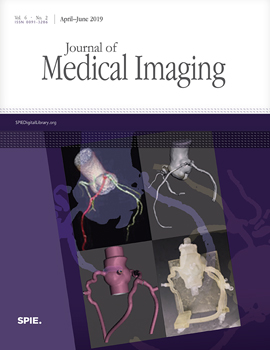Journal of Medical Imaging, Vol. 6, Issue 02, 024005, (May 2019) https://doi.org/10.1117/1.JMI.6.2.024005
TOPICS: Image segmentation, Tumors, Brain, Magnetic resonance imaging, Convolutional neural networks, 3D modeling, Neuroimaging, Feature extraction, Magnetorheological finishing, Distance measurement
Accurate segmentation of gliomas on routine magnetic resonance image (MRI) scans plays an important role in disease diagnosis, prognosis, and patient treatment planning. We present a fully automated approach, radiomics-based convolutional neural network (RadCNN), for segmenting both high- and low-grade gliomas using multimodal MRI volumes (T1c, T2w, and FLAIR). RadCNN incorporates radiomic texture features (i.e., Haralick, Gabor, and Laws) within DeepMedic [a deep 3-D convolutional neural network (CNN) segmentation framework that uses image intensities; a top performing method in the BraTS 2016 challenge] to further augment the performance of brain tumor subcompartment segmentation. We first identify textural radiomic representations that best separate the different subcompartments [enhancing tumor (ET), whole tumor (WT), and tumor core (TC)] on the training set, and then feed these representations as inputs to the CNN classifier for prediction of different subcompartments. We hypothesize that textural radiomic representations of lesion subcompartments will enhance the separation of subcompartment boundaries, and hence providing these features as inputs to the deep CNN, over and above raw intensity values alone, will improve the subcompartment segmentation. Using a training set of N = 241 patients, validation set of N = 44, and test set of N = 46 patients, RadCNN method achieved Dice similarity coefficient (DSC) scores of 0.71, 0.89, and 0.73 for ET, WT, and TC, respectively. Compared to the DeepMedic model, RadCNN showed improvement in DSC scores for both ET and WT and demonstrated comparable results in segmenting the TC. Similarly, smaller Hausdorff distance measures were obtained with RadCNN as compared to the DeepMedic model across all the subcompartments. Following the segmentation of the different subcompartments, we extracted a set of subcompartment specific radiomic descriptors that capture lesion disorder and assessed their ability in separating patients into different survival cohorts (short-, mid- and long-term survival) based on their overall survival from the date of baseline diagnosis. Using a multilinear regression approach, we achieved accuracies of 0.57, 0.63, and 0.45 for the training, validation, and test cases, respectively.



 Receive Email Alerts
Receive Email Alerts